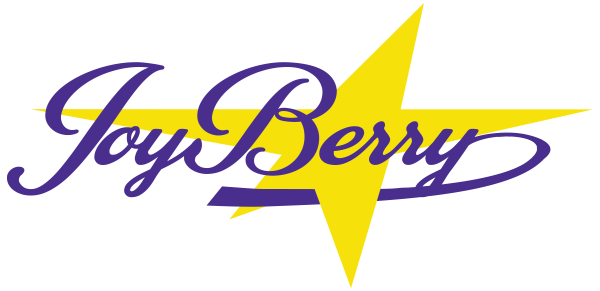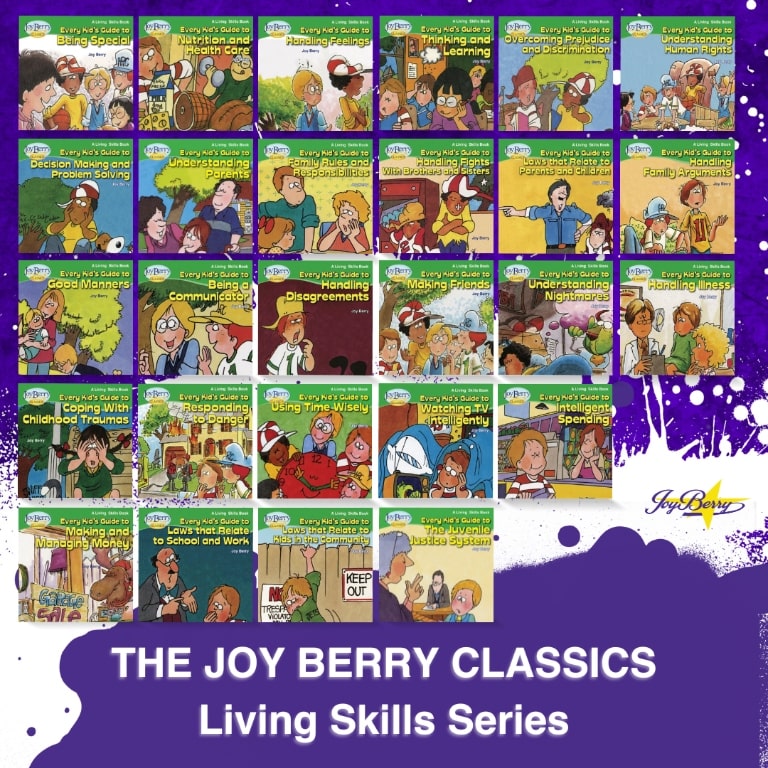The Official Joy Berry Website
Helping Kids Help Themselves
become responsible, happy, and successful
Menu
Menu
The Living Skills Books For 7–9 Year Old’s
by Joy Berry
on November 5, 2023
Having been trained in the 1960’s to teach children academics, I was unprepared for the discovery that it is just as important to teach children Living Skills as it is to teach them academics. Because Living Skills education was not a part of the educational landscape in the 1970’s and 1980’s, I developed Living Skills classes that I taught via supplementary school programs that I directed. Then, because there were no materials for Living Skills classes, I began to create them.
While the specifics of childhood issues differ from the specifics of adult issues, the essence of both childhood and adult issues are intrinsically human issues which are basically the same for children and adults. For example, while different things can cause children and adults to become angry, anger is a basic human emotion that is essentially the same for both children and adults.
Because self-help materials for children and adults address human issues, in the absence of self-help materials for children, I garnered the relevant information from adult self-help programs and materials to use in my Living Skills classes for kids.
A few years into the predictable success of my Living Skills programs, a man acquiring products for a new ABC Broadcasting affiliate (Word Books Inc.) became aware of the materials I was creating through his five children who attended my Living Skills classes. He resonated with the main goal of the classes—which was to give children the information and skills they needed to become personally and socially responsible. As a result, he approached me about the possibility of getting the materials published and I jumped at the opportunity.
Eventually Word Books Inc,—a religious publisher—established a new division of the company called “Educational Products” that allowed the publishing of secular materials for children. The first product the division launched was my 24 Ready Set Grow (RSG) children’s books. Those books were the first self-help books for kids ever published and at the time, they were the first series of books to break every direct-mail-marketing sales record throughout the world.
Later, the 120-page, black-and-white RSG books were converted into the 48-page full-color Living Skills books that became the core series in the Joy Berry Classics Library. Eventually, the formulaic format featured in the Living Skills books was applied to my two subsequent series of self-help books which included the Survival Skills and Winning Skills.
Basic Premise For The Living Skills Books
Almost all children want as much control as possible over their lives. However, control is contingent on responsibility in that the amount of control children are given over their lives is usually proportionate to the amount of responsibility they assume for their lives.
The purpose of the Living Skills books is to teach children the information and skills they need to assume the responsibility that will allow them to have more control over their lives. This is accomplished by teaching children:
• The personal skills they need to take care of themselves,
• The social skills they need to develop and maintain positive relationships, and
• The coping skills they need to relate to things in positive rather than negative ways.
The Living Skills books are considered to be the heart of the Joy Berry Classics Library as the three self-help book series that precede Living Skills (the Teach Me About, Let’s Talk About and Help Me Be Good series) prepare children to learn the basic Living Skills taught via the Living Skills books. In addition, the two self-help book series that follow Living Skills (the Survival Skills and Winning Skills series) build upon the basic Living Skills taught via the Living Skills books.
Basic Layout And Contents Of The Living Skills Books
Each Living Skills 48-page self-help book speaks directly to children 7 – 9 years of age about subjects they encounter in their daily lives. The minimal, straightforward text is written in the third person to accommodate an older child’s natural resistance to being lectured.
In order to ensure that these books are not boring, ½ to ¾ of every page features a full-color cartoon illustration. Because the purpose of the illustrations is to clarify the text, the text is situated above the illustration to ensure that the child reads the text before looking at the illustration.
In order to present the information in “bite sizes” that are “easier to digest,” each book is divided into four or more sections. The section titles are displayed at the top of each page to help children keep track of the information that is being presented.
Living Skills self-help books feature the vintage Human Race Club characters. They also feature animal characters that are added to the illustrations in an effort to make the book more humorous and entertaining.
Developmental Organization Of The Living Skills Books
The practice of organizing the self-help book series in the Joy Berry Classics Library into developmental grids began with the initial Living Skills classes that I taught.
The board of directors for my Living Skills programs was always made up of ½ kids and ½ adults. This practice was based on the fact that kids are often the best resource for determining what they need and want to learn.
It was standard procedure for the board to get together before the beginning of every upcoming session to determine which Living Skills classes should be offered during the new session. Before one such gathering, I wrote on 3X5 cards the names of all of the classes that had ever been offered. I spread out the cards on a huge table and we considered the cards one-by-one. During the deliberations, we eliminated all of the classes that were a one-off based on the interest of a small group of kids. The cards that remained pertained to the classes that were always in demand—classes such as Making Money, Making Friends, Handling Sibling Rivalry, and so on.
When we examined the cards on the table, we noticed that they could be organized into a logical developmental sequence. This was due to the inevitable conclusion that one class often required the information learned from other classes in order to be completely successful. For example, while kids often wanted to learn how to make money, we found that they first needed to know how to manage their time. And before they could understand time management, they needed to understand how to establish goals, etc.
The organic organization of the cards on the table became the developmental grid for the Living Skills classes—and eventually the Living Skills books. And the Living Skills developmental grid became the template for the developmental grids for the additional series of books that followed the Living Skills.
It should be noted that, only after acquiring my master’s degree in human development, did I realize that the developmental grids put together for all of the series in the Joy Berry Classics Library are totally in sync with the normal growth and development of a child’s life. And, just as there are stages in a child’s physical, cognitive, emotional, social, and moral development, there are stages in the way a child transitions into personal and social responsibility.
Therefore, based on every child’s normal developmental progression from being egocentric–to being social–to caring about the things that surround them, it is recommended that the Living Skills subjects be presented in the following developmental sequence:
Personal Skills
• Self Esteem
• Human Sexuality
• Health and Nutrition
• Emotions
• Rights and Responsibilities
• Prejudice and Discrimination
• Thinking and Learning
• Decisions and Problems
• Personal Goals
Social Skills
• Manners
• Communication
• Disagreements
• Friendships
• Parent/Child Relationships
• Sibling Relationships
• Family Rules and Responsibilities
• Family Arguments
Coping Skills
• Nightmares
• Illness
• Danger
• Trauma
• Time Management
• Money Management
• Consumerism
• Family Law
• School Law
• Community Law
• The Juvenile Justice System
Individual Living Skills Book Descriptions
The Every Kid’s Guide to Being Special book explains how every person is unique and encourages kids to accept and value themselves.
The Every Kid’s Guide to Nutrition and Healthcare book encourages self-care via good nutrition, exercise, cleanliness and rest.
The Every Kid’s Guide to Handling Emotions book teaches how to handle emotions in positive rather than negative ways.
The Every Kid’s Guide to Thinking and Learning book teaches the intellectual skills that can help kids become lifelong learners.
The Every Kid’s Guide to Overcoming Prejudice and Discrimination book teaches how to avoid or overcome harmful prejudice and discrimination.
The Every Kid’s Guide to Understanding Human Rights book defines kids’ basic human rights and responsibilities.
The Every Kid’s Guide to Decision Making and Problem Solving book teaches how to make intelligent decisions and resolve problems.
The Every Kid’s Guide to Understanding Parents book explains the rationale for respecting, appreciating and obeying parents.
The Every Kid’s Guide to Handling Fights with Brothers and Sisters book addresses sibling rivalry and relationships.
The Every Kid’s Guide to Family Rules and Responsibilities book teaches how to help create and support family rules & regulations.
The Every Kid’s Guide to Handling Family Arguments book explains the causes of family arguments and how to resolve them.
The Every Kid’s Guide to Laws that Relate to Parents and Children book explains parent/child legal rights and responsibilities.
The Every Kid’s Guide to Good Manners book teaches good manners and how to behave graciously in various situations.
The Every Kid’s Guide to Being a Communicator book explains how to communicate honestly, accurately, and effectively.
The Every Kid’s Guide to Handling Disagreements book explains how conflicts develop and how to resolve them in positive ways.
The Every Kid’s Guide to Making Friends book teaches the importance of friendships and how to make and keep friends.
The Every Kid’s Guide to Understanding Nightmares book teaches kids about nightmares and how to avoid or handle them.
The Every Kid’s Guide to Handling Illness book teaches how to prevent illness and how to get well when sick.
The Every Kid’s Guide to Responding to Danger book teaches how to handle dangerous people, objects, places, and situations.
The Every Kid’s Guide to Coping with Childhood Trauma book defines trauma and how to handle it in constructive ways.
The Every Kid’s Guide to Using Time Wisely book teaches how to organize time in order to accomplish personal objectives.
The Every Kid’s Guide to Watching TV Intelligently book encourages choosing TV programs wisely and setting limits on watching TV.
The Every Kid’s Guide to Making and Managing Money book teaches how to make money and handle it appropriately.
The Every Kid’s Guide to Intelligent Spending book teaches how to be an intelligent consumer.
The Every Kid’s Guide to Laws that Relate to School and Work book explains the laws that relate to kids while they are at school.
The Every Kid’s Guide to Laws that Relate to Kids in the Community book explains the laws that relate to kids in their communities.
The Every Kid’s Guide to The Juvenile Justice Systems book explains how the juvenile justice system works.
Guidelines For Using The Living Skills Books
In order to derive the maximum benefits from the Living Skills books it is recommended that adults use the books in the following ways:
Adult Resource: The adult reads the books for information, insights, and encouragement.
Adult-Child Activity: The adult introduces the books to the child and encourages the child to question or comment on the subject matter.
Independent Activity: The child is encouraged to use the books independently of the adult for entertainment and to reinforce the subject matter.
Reference Material: The books are placed in the child’s library along with other books and used whenever specific situations need to be addressed.

Menu
Copyright © 2024 Joy Berry Enterprises. All Rights Reserved.




Leave a reply